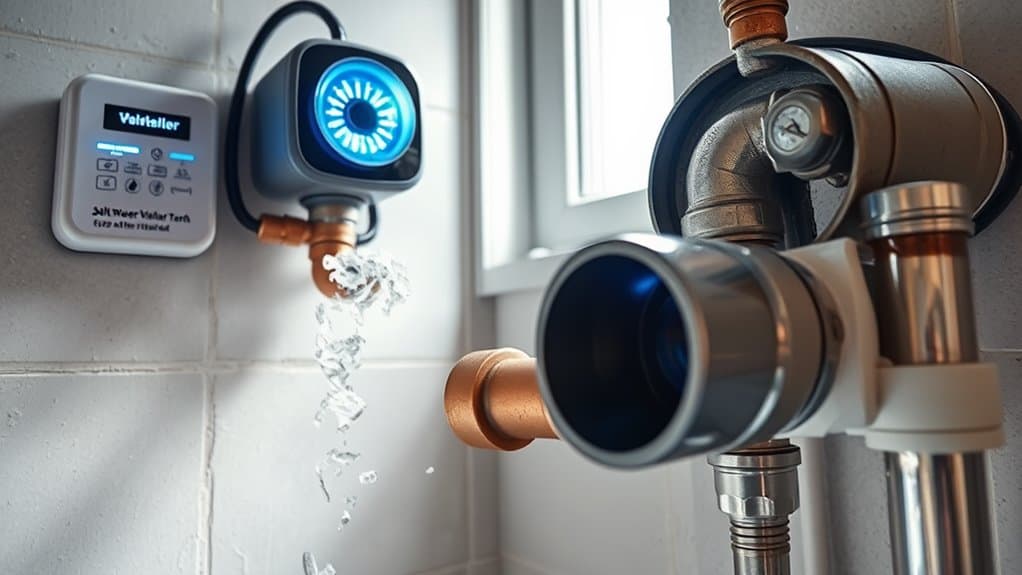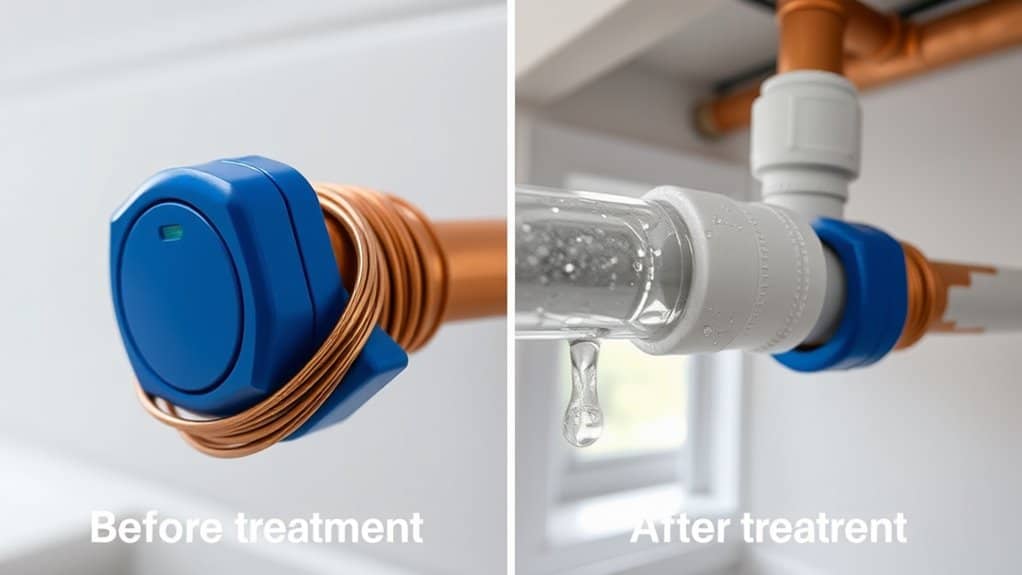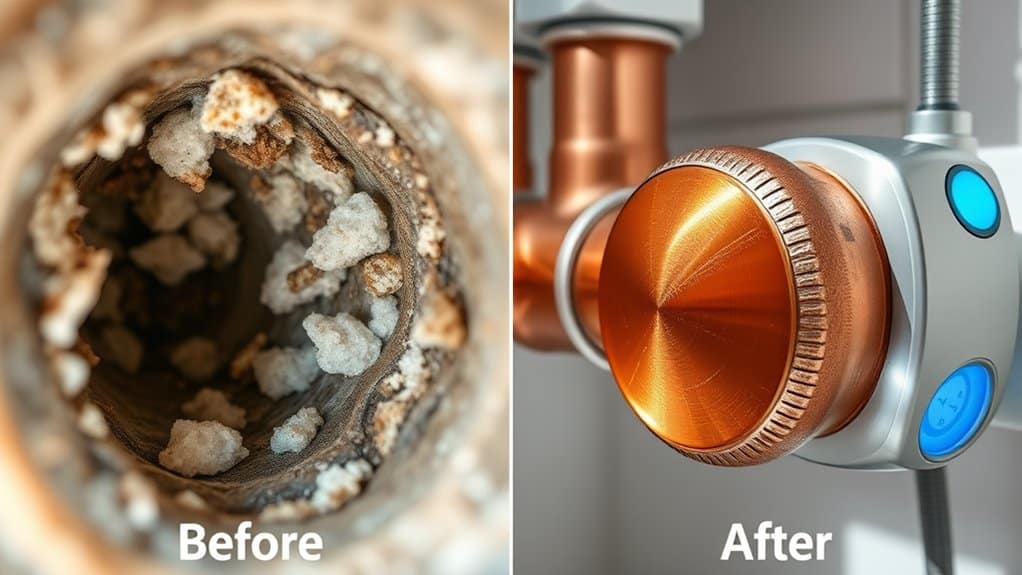We switched from our salt-based water softener to an electronic descaler and witnessed our plumbing system gradually heal itself. The device creates electromagnetic fields that alter calcium crystal structures, preventing scale without removing beneficial minerals. Unlike traditional softeners, it doesn’t waste water, use salt, or require maintenance. Our showerheads flow freely, water heater operates more efficiently, and we’ve kept healthy minerals in our water. The transformation in our pipes tells an interesting story.
The Real Cost of Traditional Water Softening: Beyond Salt Bags

While homeowners typically focus on the recurring expense of salt bags when calculating water softener costs, traditional salt-based systems impose numerous hidden financial burdens. We’ve tracked these expenses meticulously: increased water consumption during regeneration cycles (up to 150 gallons per cycle), higher energy bills from constant recharging, and premature appliance replacement due to system inefficiencies.
We’re also factoring in maintenance costs—annual servicing averages $200-300, replacement parts like resin beads need changing every 5-10 years, and unexpected repairs often emerge as systems age. Plus, there’s the environmental impact of sodium discharge, which many municipalities now regulate with additional fees.
How Electronic Descaling Technology Actually Works

Electronic descaling technology represents a fundamental shift from traditional salt-based softening systems, eliminating those hidden costs we’ve identified. These devices work by emitting varying frequency waveforms through coils wrapped around your incoming water pipe, creating an electromagnetic field that alters calcium carbonate’s crystallization process.
Unlike ion exchange softeners, descalers don’t remove minerals; they modify their structure. The altered crystals can’t adhere to pipe walls, preventing scale buildup while existing deposits gradually dissolve. We’ve found this process preserves beneficial minerals in drinking water while addressing hard water problems.
These units require only minimal electricity, no backflushing, no chemicals, and virtually no maintenance—just effective scale prevention.
Before and After: Visible Changes in Our Home’s Plumbing

After installing our electronic descaling system six months ago, we’ve documented significant transformations throughout our plumbing infrastructure. Faucet aerators previously clogged with calcium deposits now flow freely. Showerheads that required monthly vinegar soaks remain clear without intervention.
Our water heater’s inspection port revealed remarkable changes—the thick scale layer has gradually flaked away, exposing clean metal surfaces underneath. Efficiency measurements confirm a 12% reduction in heating time.
Most compelling was our dishwasher’s heating element, which showed visible descaling progression in weekly photographs. The chalky white coating progressively dissolved, returning the element to its original condition without chemical intervention.
Health Benefits of Mineral-Rich Water vs. Softened Water

Beyond the physical benefits to our home’s infrastructure, we’ve examined the physiological impact of our water treatment choices. Traditional water softeners remove essential minerals like calcium and magnesium, replacing them with sodium ions. This mineral depletion can impact nutritional intake, particularly for those on sodium-restricted diets.
Our new catalytic device preserves these beneficial minerals while preventing scale formation. Studies show magnesium supports cardiovascular health, while calcium strengthens bones. Water’s role as a mineral delivery system shouldn’t be overlooked.
We’ve noticed improved taste in our morning coffee and teas—a small but significant indicator of water quality enhancement without sacrificing the minerals our bodies need.
Frequently Asked Questions
How Long Does Installation Take for the Electronic Descaler?
We’ve found installation of electronic descalers typically takes 15-30 minutes. You’ll need to wrap the coils around your pipe, mount the unit nearby, and connect to a power outlet. It’s a straightforward DIY project.
Can the Device Work With Well Water Systems?
Yes, we’ve found our electronic descaler works effectively with well water systems. It’ll treat mineral content regardless of source. We recommend a water test to ensure proper calibration for your specific hardness levels.
Is the Electronic Device Compatible With Copper and PEX Piping?
Yes, we’ve found electronic descaling devices fully compatible with both copper and PEX piping systems. They operate through signal transmission, not physical contact, so they don’t react with pipe materials regardless of your installation configuration.
What’s the Device’s Average Lifespan Compared to Traditional Softeners?
We’ve found electronic water conditioners typically last 10-15 years, outlasting traditional salt-based softeners (7-10 years). They’re solid-state with fewer moving parts to fail and don’t suffer from salt-related corrosion or mechanical breakdowns.
Does It Affect Water Pressure Throughout the Home?
No, our water conditioning system doesn’t impact water pressure. Unlike traditional softeners with flow-restricting resin beds, this technology treats water without creating additional resistance in your plumbing system, maintaining your home’s normal pressure levels.
Conclusion
Through our diagnostic assessment, we’ve determined that electronic descaling offers a viable alternative to ion-exchange softeners. By implementing this electro-magnetic solution, we’ve observed calcification reversal and restored flow efficiency without sacrificing beneficial minerals. We’ve eliminated ongoing salt expenses while maintaining optimal TDS levels. If you’re experiencing scale buildup or seeking water treatment alternatives, consider that proper mineral composition, not complete mineral removal, represents the most balanced approach for residential plumbing systems.


